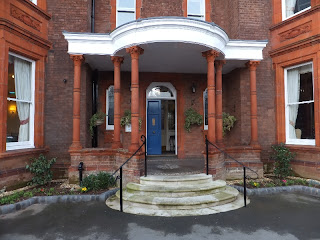A year or so ago, one of the local free magazines featured our neighbourhood as a good place to live, and included the description: “St Leonard’s is the Notting Hill of Exeter”, referring to the film that starred Hugh Grant in 1999. I commented on this amusing description to one of my friends, and she retorted, “Nonsense! Notting Hill is the St Leonard’s of north London!” Let’s put our national capital in its place.
Several of the scenes in the film centre around the front door and porch of William Thacker’s (Hugh Grant) flat. This issue, let’s have a look at the porches of our neighbourhood. And there is a huge variety. A porch is a structure whose purpose is to shelter and cover the front door. It is a small extension of our living space, a place where we move between the outdoor world and the security behind our front door. In that simple description, there has been scope for the imagination of architects and house owners.
Looking round St Leonard’s, it is quite difficult to categorise porches. Of course, not all houses have a porch. For a lot of houses the front door is in a shallow recess, offering a small amount of protection from the weather – provided the wind is in the right direction. Then there are some very simple porches, which offer a roof over the front step. Again, these are numerous in the streets of St Leonard’s. But look a little closer at the variety of roofs. It may be a flat projection, supported by brackets on each side. Or it may be pitched like a gable, draining to each side. Or it may be sloping, to left, right, or away from the house. The roof may match the house roof, indicating that it was planned to be an original part of the house. Thus many local houses have tiled porches, but others have clear glass panels above the front doorstep. In St Leonard’s Road, there are porches which resemble tents.
Look at the way such porches are supported; is there a beam across a wider space than the front door space? Or is the porch as wide as the door and little more than that? If the latter, is the roof on brackets, or is it supported on pillars? So what shape is the pillar, and what shape is the beam? Some porches are in a corner, needing one pillar, others have two.
Several older houses have flights of steps leading into the porch, or through the porch to the front door (pre-dating concerns of access for disabled people). Sometimes this creates a plinth for the porch, designed to impress the visitor. I have mentioned the mosaics at the entrance to The Lodge in Spicer Road in an earlier article. Other houses have rooms above a projecting porch, in the way that is often associated with Devon farmhouses. You’ll find examples of these in several roads, in houses of the twentieth century and earlier.
Instead of having the porch outside the house, there are many houses whose porch is integral with the building, in a recess. Many of these have been modified with panels to create an enclosed porch, just as many projecting porches have been enclosed. The result changes the architecture of the building, while providing a new room at minimal cost. It is interesting to wander down some local streets to see houses which were built at the same time, and whose porches may have been modified. Has it always been for the better?
Last of all, there are the porch rooms which were designed as part of the house, found in several Victorian houses in Denmark Road, and the older houses of Friars Walk and Magdalen Road. Once again, they offer a space for discarding outer garments, storing umbrellas and walking sticks, overwintering house plants and have a hundred and one other uses.
My favourite local porch has to be that of The Lodge in Spicer Road, but those at Woodhayes in St Leonard’s Road and The Maynard School in Spicer Road run it a close second. There’s a set of fine ones in Wonford Road below Woodhayes, and another in Victoria Park Road. Have a look for yourself and see which you find the most interesting!
Thinking about porches, there was a time when house names were written above the front door, on the lintel or on a pane of glass. Many houses in Denmark Road still have their names like this.
And while you are looking at porches, keep a look-out for the houses which still have coach houses. The wealthy Victorians who moved to St Leonard’s needed coach houses for their horses and carriages and some of these buildings remain, in Denmark Road, Lyndhurst Road, Victoria Park Road and elsewhere. Does anyone know which is the most recent house in the neighbourhood to have been built with a coach house? I wonder how many coach houses there are in Notting Hill?
(September-October 2011)
 |
| The porch of The Lodge in Spicer Road |
















